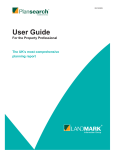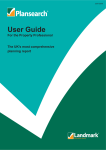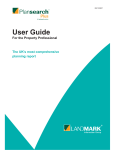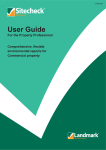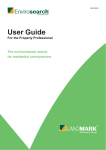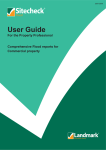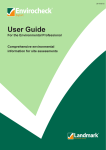Download User Guide November 2002
Transcript
User Guide November 2002 Landmark Information Group Limited 6 - 7 Abbey Court Eagle Way Sowton EXETER EX2 7HY DX 135607 Plansearch Commercial Helpline: 01392 441723 Switchboard: 01392 441700 Fax: 01392 441709 E-mail: [email protected] Internet: http://www.landmarkinfo.co.uk A Daily Mail and General Trust Company Plansearch Commercial User Guide Table of Contents Introduction P.3 What is Plansearch Commercial? P.3 The Planning Process P.3 How do I get a Plansearch Commercial? P.4 What does my Plansearch Commercial tell me? P.5 How do I proceed now? P.9 Appendix Appendix 1 – Development Plan Tracker, Planning Applications, Land Use Policies & Flooding Information P.10 Appendix 2 – Scope of Planning Applications P.14 Appendix 3 – Datasets P.16 Appendix 4 – The National Grid P.18 Published by Landmark Information Group, November 2002 Version 1: This User Guide has been prepared by Landmark Information Group Limited. © Landmark Information Group Limited 2002. All rights reserved. Version 1 A Landmark Information Group Service 2 1. Introduction 1.1. Landmark Information Group is the leading supplier of planning, environmental, land-use and mapping information in Great Britain. Having established a reputation for producing accurate, comprehensive, timely and user-friendly reports, Landmark’s clients include virtually all the largest firms of civil engineers, environmental consultants, surveyors, developers, house builders, lawyers, insurers and banks. 1.2. This guide has been prepared by Landmark Information Group Limited to inform and provide guidance to users on how to effectively use Plansearch Commercial and explain the scope and benefits of the report. 1.3. This guide will be regularly updated to reflect any changes to the product and to the legal or practical framework, where relevant. A copy of this guide is available free of charge at www.landmarkinfo.co.uk. 2. What is Plansearch Commercial? 2.1. Plansearch Commercial is a planning report specifically tailored to property professionals including lawyers, conveyancers, developers, house builders, surveyors, investors, valuers, managers, owners and buyers. 2.2. Investing and collating the planning history of a site and the surrounding area, and searching for the relevant sections within the Development Plan (once the most up to date plan has been found) can be a very lengthy process. Plansearch Commercial can help by providing all the information required in one easy to use, illustrated report. It contains information on the following: Development Plan Tracker – a listing of relevant development plans Large Planning Applications, made since 1997, with an estimated development cost of over £100,000, within 500m of the site boundary Small Planning Applications, made since 1998, with an estimated development cost of under £100,000, within 250m of the site boundary Land Use Policies derived from the development plan, within 500m Flooding information within 500m of the site boundary 2.3. Plansearch Commercial is designed and priced to be part of every commercial property/site screening process, and should be obtained at the beginning of every commercial evaluation or transaction. 3. The Planning Process 3.1. The need for Plansearch Commercial arises from the fact that the planning process is very complex. The report includes planning information of two types: one derived from local authority development plans and the other from individual planning applications and decisions. 3.2. Development plans are the statutory documents prepared by local planning authorities that set out the policies and proposals for future development and use of land, they also incorporate the planning policies of central government. There are different types of local authority, but they all have a role in preparing the development plan for their area, whether they are, for example a District Council, County Council, Unitary Authority or National Park Authority. Plans are substantial and very detailed and subject to review and amendment. A plan goes through different stages before it is finally agreed and in place (‘adopted’), it may be a proposed alteration or replacement which has been proposed formally (often called a ‘deposit’ plan). The cycle from one ‘adopted’ plan to another can vary but is generally around five years. Version 1 A Landmark Information Group Service 3 3.3. The development plan has important practical consequences. It provides the framework for consulting the public and other bodies on proposed land uses and development, and, once a plan has been formally adopted, it is the required starting point for making individual planning decisions. Development plans include general statements of policy, but they must also include detailed policies which often relate to specific pieces of land. For example, they might indicate areas suitable for housing, retail, industrial, commercial, or conservation uses. They therefore give an early indication of likely future uses of land and are a crucial starting point in determining the planning context of any piece of land. 3.4. The second type of planning information included in the Plansearch report comprises individual planning applications made in the context of the development plan. Applications for planning permission are submitted to the relevant local planning authority and their details are added to the planning register and maintained by that authority for public inspection. Applications generally must also be notified to local residents immediately adjoining the site, or advertised through a notice on the proposed development site itself. 3.5. A planning officer for the authority will consider the application, taking into account a wide range of factors. These will include the planning history of the property and relevant adjoining sites, comments from local residents, and policies included or proposed in the development plan. A visit to the site may also be made before a report is prepared and a recommendation is submitted to the relevant committee of the planning authority, which will usually make the decision. In most cases a decision should be reached within 8 weeks of the application being made. Unless acted upon, a planning permission usually lapses after 5 years. Once a decision is made it too will be added to the planning register. 4. How do I get a Plansearch Commercial? 4.1. The quickest and easiest way to order a Plansearch Commercial report is via our website, www.landmarkinfo.co.uk. Ordering via the web enables the user to accurately locate the site on current large-scale Ordnance Survey mapping and order a report for the exact site required. The report can then be delivered by email as a .PDF or as a paper report. Call our Customer Services team on 01392 441728 to set up your individual user name and password. 4.2. To order a report by traditional methods please contact Customer Services using the details below: Landmark Information Group Limited 6-7 Abbey Court Eagle Way Sowton Exeter EX2 7HY Telephone: Fax: DX: E-mail: Internet: 01392 441728 01392 441709 135607 Exeter 16 [email protected] www.landmarkinfo.co.uk. 4.3. If ordering a Plansearch by the traditional method it is recommended and requested that a location plan clearly showing the site boundary in relation to established surface features is supplied. If the site is a new development the developer’s plan and Land Registry plan should be submitted to aid us in site identification. If in doubt please call for clarification, as orders submitted without a location plan may be delayed. 4.4. Orders and plans should be sent by post, fax or by DX to the address above. Version 1 A Landmark Information Group Service 4 4.5. Reports may be received electronically in .PDF format within 24 hours, or in 2 working days if a paper report is required. 4.6. The fees charged in respect of the searches are reviewed from time to time. The current fees and methods of payment can be ascertained by contacting Landmark Customer Services. 5. What does my Plansearch Commercial tell me? 5.1. General Information 5.1.1.The report includes information from a number of sources. The Development Plan Tracker information is derived from the Development Plan Monitoring Database supplied by Dev Plan UK. 5.1.2.The planning application information has been supplied to Landmark Information Group Limited by ABI Building Data Limited. ABI has over 60 years experience in gathering, processing and publishing detailed information on property and construction developments. ABI Building Data Limited is part of Bertelsmann Group – one of the largest media groups in the world and the leading supplier of construction information across Europe. 5.1.3.The information derived from the development plans has been obtained from the local planning authorities. For ease of use, this information has been standardised into 10 categories for the whole of Great Britain, making it easier to compare information on Land Use Policies from different local authorities (for further information see section 5.6.3). 5.1.4.The flooding information used in Plansearch is obtained from the Environment Agency for England and Wales and from the Centre for Ecology and Hydrology for Scotland. Local authorities also hold information on flooding. This is sometimes included in the development plan. 5.1.5.The Plansearch report is based on the datasets listed in Appendix 3 to this Guide. The Users attention is drawn to the update cycles for this information. Landmark’s Terms and Conditions apply to the use of the Plansearch report. 5.1.6.Landmark Information Group is constantly working with data providers to improve the datasets and so the information available to Landmark may change from time to time. 5.1.7.Users should not re-use old reports as subsequent planning decisions and processes can rapidly supersede the data. The report is valid at the time it is delivered to the Users and is supplied subject to Landmark’s Terms and Conditions. 5.2. High Quality Location Maps 5.2.1.Two location maps are provided in the report, both are derived from Ordnance Survey data. The main map confirms the boundary of the subject site, which is marked in magenta. Users should check the boundary is correct on receipt of their Plansearch report and call our Customer Services team on 01392 441728 if there is an issue with the boundary. 5.2.2.Since all sites differ in shape and area the maps are not reproduced at a set scale. The minimum distance from the site boundary to the map frame boundary is 50m. 5.2.3.The second map, which is at a smaller scale, shows the location of the property in relation to local features, such as streets and schools and the Plansearch search zone Version 1 A Landmark Information Group Service 5 buffers (marked in blue) positioned at 250m and 500m from the site boundary. 5.2.4.Adjacent to the above map you will find the site location description and a 6 figure National Grid Reference, relating to the centre of the site, although mapped accurately this rounded to the nearest 10m. To convert this National Grid Reference to an alphanumeric string, please refer to page 18. 5.3. Summary 5.3.1.The Summary is split into two sections, the first one outlines the following details for the site: Property address details ‘Large’ Planning Applications ‘Small’ Planning Applications Land Use Policies applicable Flooding Local Authority Areas 5.3.2.The second section in the Summary outlines the following details for the search area: Number and classification of ‘Large’ Planning applications within 500m of the site boundary Number and classification of ‘Small’ Planning applications within 250m of the site boundary Number and classification of Land Use Policies within 500m of the site boundary 5.4. Development Plan Tracker 5.4.1.This information is derived from the Development Plan Monitoring Database supplied by Dev Plan UK. This database contains information regarding the lifecycle of current and emerging plans throughout Great Britain. A development plan is a planning policy document that provides planning guidance and may be published by Local Authorities, County Councils and Park Authorities. There are a variety of different types of plans including: Local, Unitary, National Park, Structure, Mineral, Waste, Mineral & Waste and Regional Park. 5.4.2.The information provided details the development plan title, type, status, stage(s) completed with dates (or periods) and any relevant comments. The process of adopting a plan is dynamic and at times lengthy. For those plans that are currently being prepared, the relevant stage(s) in each plans preparation are recorded. 5.4.3.The list of development plans is based on boundary information available to Landmark at this time. As a result of this some plans relating to neighbouring authorities may be shown. 5.5. ‘Large’ and ‘Small’ Planning Applications 5.5.1.Plansearch contains information of applications made for planning permission which have been supplied by local authorities. The report has been divided into two separate sections for ease of use – ‘Large’ Planning Applications and ‘Small’ Planning Applications. 5.5.2.‘Large’ Planning Applications section – applications made since 1997, with an estimated development cost of over £100,000 – the search radius is 500m from the site boundary. 5.5.3.‘Small’ Planning Applications section – applications made since 1998, with an estimated development cost of under £100,000 – the search radius is 250m from the site Version 1 A Landmark Information Group Service 6 boundary. 5.5.4.For ease of use, planning applications have been classified in the following way: Housing developments or alterations Civil engineering construction or maintenance projects (e.g. bridges, runways etc.) Transportation facilities (e.g. petrol stations, car parks, airports, etc.) Sports/ Leisure developments or alterations Education/ Health developments or alterations Commercial/ Retail developments or alterations Power/ Water/ Telecom developments or alterations Hotel/ Catering developments or alterations Industrial/ Agricultural developments or alterations and all demolitions Public Building developments or alterations 5.5.5.For each application the direction and distance from the subject property/site is provided, together with the classification, title, location, development type, category, stage, application reference and date, project size, floor space, number of units, area and positional accuracy. 5.5.6.The background mapping used to display the Planning Applications is Ordnance Survey Internet Street Mapping. All planning applications featured in the report are plotted as a symbol on the map (a Legend is provided) and have a Map ID with corresponding text provided in the main body of the report. 5.6. Land Use Policies 5.6.1.Plansearch provides a summary of policies for future development and land use within the area. A description of the source from which the information was derived (including plan title, status, and date published) is provided. Please note for the purposes of this report information is derived from the latest adopted or deposit version of the statutory local plan. 5.6.2.The search radius for land use policies is 500m from the site boundary. 5.6.3.To ensure consistency and ease of use, the information derived from the development plans has been standardised across Great Britain to the following: Version 1 Housing - residential and other housing developments, including re-development and conversion. Transport - transportation including planned corridors for new roads, minor and major road and rail alterations and a diverse range of cycle, pedestrian and parking policies. Open Land - includes green belts, nature conservation areas, Sites of Special Scientific Interest (SSSI), etc. Constraints normally relate to the preservation of such areas and restrictions on residential or any other development. Heritage Environment - areas of many towns are designated as conservation areas under statutory powers. Additional statutory hurdles will be in place, and policy constraints are also often imposed concerning the types of construction that will be allowed. Town Centre and Retailing – includes retail areas, retail servicing areas and town centres. Industrial and Commercial - includes commercial development sites, offices, warehousing, hotels and business and industrial use in general. Community and Social Facility – includes health, education, sport, leisure and social areas and allotments. Waste, Pollution, Minerals, Water and Energy - includes waste processing and disposal sites, land use for utility purposes (such as sewerage) and potential development hazard areas. Rural/ Settlement - villages and other rural areas, urban areas. A Landmark Information Group Service 7 Other Site-Specific - areas and sites not covered by the previous classifications. Includes mixed use and special policy areas and sites. It should be noted that these classifications may change over time. 5.6.4.For each classification the direction and distance from the subject property is provided together with a brief description, the chapter, policy* and plan reference. * At the end of the Land Use Policy Section a table of the policies relevant to the search area and their corresponding policy headings is provided. 5.6.5.The background mapping used to display the Land Use Policies is the latest Ordnance Survey Internet Street Mapping. The symbols/lines/polygons are plotted on the map (a Legend is provided), although please note where two or more lines need to be shown in exactly the same position only the most important line will be shown, and the order of importance is as follows: Transport Housing Industrial and Commercial Waste, Pollution, Minerals, Water and Energy Town Centre and Retailing Community and Social Facility Heritage Environment Open Land Other Site-Specific Rural/ Settlement 5.7. Flooding 5.7.1.For England and Wales the flooding assessment has been provided by the Environment Agency (EA). Plansearch is able to identify whether the subject property/site or the surrounding area is located in: an indicative river floodplain an indicative coastal floodplain 5.7.2.For Scotland the flooding information is provided by the Centre for Ecology and Hydrology (CEH). Plansearch is able to identify whether the subject property or the surrounding area is at risk from flooding from non-tidal rivers. 5.7.3.Flood risks at any specific location may be influenced by local factors which are not included in the report. These include: flooding from minor rivers and streams any flood defences that may be in place 5.7.4.An outline of the potential flood area will be illustrated on the flooding map. 5.8. Useful Contacts 5.8.1.Having read the details identified in the report please contact the relevant organisation listed in the Useful Contacts section, quoting the details supplied in this report if further information is required. 5.9. Useful Information 5.9.1.The Useful Information section at the back of the report is a summary of this User Guide and is intended to help those analysing the report understand its contents. Version 1 A Landmark Information Group Service 8 6. How do I proceed now? 6.1. Plansearch constitutes what is known as a ‘desk study’, which is an information-gathering exercise and is designed to help the Users decision making process relating to possible next steps. 6.2. If the results are clear or there are no perceived problems the User may proceed safe in the knowledge that quality information has been obtained. 6.3. Searches showing planning information of concern - in some cases the search will reveal entries that may be of some concern. If further information is to be sought the User should use the Useful Contacts section to determine who the contact is and contact the relevant organisation quoting the planning application reference or plan name, policy and chapter. Version 1 A Landmark Information Group Service 9 Appendix 1 – Development Plan Tracker, Planning Applications, Land Use Policies and Flooding Information 1. Development Plan Tracker This section of the report provides details of the current and emerging development plans. The information supplied includes title, type, status, stage(s) completed with dates (or periods) and any relevant comments. For those plans that are currently being prepared, the relevant stages and dates/periods in each plans preparation are recorded, which may include: Approval or adopted date Issue Papers period* First Deposit period* Second Deposit period* Pre Inquiry period* Public Inquiry period* Inspectors Report date Post inquiry period* Operative date Legal Objection End date * Note: Where possible the start and end date of the period will be supplied, however on some occasions only one date is supplied and therefore only this will be shown in the report. 2. Planning Applications 2.1. The following is an explanation of the descriptions used in the report: Title: a brief description of the planning application Location: based on details provided by the local authority (see Positional Accuracy below). Development type: states the kind of application that has been made. Categories include; new builds, conversions, refurbishments, repairs, and demolitions. If a ‘new build’ is reported it is possible the development has not been built yet and not shown on the accompanying map, however if it is shown the address and map reference is likely to be approximate. If any other category is shown it is likely that the area being developed will already be shown on the map, in part or completely. Category: describes the type of development applied for, and includes categories such as: offices, commercial and retail, and several types of residential development. Stage: there are 15 stages in total which tell you at what stage an application for planning permission is, for example detail planning, detail approval etc. – see ‘Project Size’ for more detail. Application ref: is the reference given to the application for planning permission by the local planning authority to which the application has been made. If you wish to enquire about a particular application, contact the relevant local planning authority quoting this reference. Date: the date that the application was formally submitted to the local authority by the client or agent, which would only change if an ‘Outline’ application is then approved and a ‘Detail’ application takes it’s place. Plansearch reports on applications since 1997 for ‘large’ projects and since 1998 for ‘small’ projects. Project size: highlights whether the development is small or large according to an estimated development cost of under £100,000 (small) and over £100,000 (large). (Note: Large developments are usually tracked throughout their lifecycle until a final decision is made– see Appendix 2 for more details). Floor space: measured in square metres, provides a measurement of the proposed floor space of a development (i.e. of every level of a development) No. of Units: relates to the number of units proposed for the development. Area: measured in square metres, provides a measurement of the total area of the development. Positional accuracy: indicates the likely accuracy with which an application has been found on the map. Planning applications are given a geographical position on the map according to the address given in the planning application itself. Circumstances will exist where the Version 1 A Landmark Information Group Service 10 address supplied is incomplete and an approximate position has been inferred from the incomplete details. The positional accuracy statement will show this – for example ‘Manually positioned within the geographical locality’. 2.2. Road, Rail, Utility and Large Development Planning Applications Road, rail, utility and large development applications often do not have definite addresses but are identified with general descriptions. As a result, this report may show such applications by reference to a single point rather than the whole length/area of the project. In many cases the projects will be about changes to existing infrastructure (e.g. road resurfacing and existing buildings), and therefore may be identified by using the map. However, in cases of ‘new build’, identifying the length/area of the project is more difficult, although for large developments the floor space, no. of units and area can be used to estimate the size of a development. In all circumstances there is the possibility that the single point reference will not be found within the search area. For this reason, for road, rail utility and large development applications, the Land Use Policies section (section 2 of the report) should be referred to. We suggest that you then contact the relevant local planning authority for further information. 2.3. Minor developments This report does not include information on applications for planning permission for developments of a very minor nature, such as conservatories, porches, signs and car ports (see Appendix 2 for further examples). 2.4. Permitted Developments Some developments do not require an express grant of planning permission, perhaps because its impact on an area would be small, or because it would involve a land use which is very similar to an existing use. This sort of development often takes place under what are known as ‘permitted development rights’, and it is therefore often referred to as ‘Permitted Development’. Examples of permitted development rights include, changes to the inside of buildings, or small exterior alterations that do not significantly alter the volume or area of a building. In some areas of the country permitted development rights are more restricted. This may be because land is within an area designated as a National Park or Conservation Area, or it may be because a local authority has formally decided to revoke or modify permitted development rights under what is described as ‘article 4 direction’. 3. Land Use Policies Local Plans, from which the Land Use Policy information has been derived, are produced by local planning authorities and go through an elaborate consultative exercise before they may be formally adopted as policy. This process includes the preparation and publication of deposit drafts, modifications proposed or made as a result of a planning inspector’s report and the final adopted plan itself, which is the authoritative source of the policy. Please note for the purposes of this report information is derived from the latest adopted or deposit draft version of the statutory development plan. Users of this report are advised to consult with the authorities in the Useful Contacts section to determine the status of the relevant development plan. 3.1. Policies Where policy numbers have been identified these relate only to the distinct geographical areas shown on the Information Map. Users should also be aware that all local planning authorities have general policies, which apply either throughout the authority’s area and/or apply generally to particular land use descriptions. These general policies have not been included in the report. Version 1 A Landmark Information Group Service 11 3.2. Sources The Land Use Policy information that has been used for this report has been derived from the latest adopted or deposit version of the statutory development plan. In some areas there are two ‘levels’ of plan, either structure plans (or Part I of a unitary development plan), which are strategic and general, and local plans (or Part II of a unitary development plan) which are specific and particular. Structure plans have not been used as a source as the policy information contained should have been taken into account by other local planning authorities in the production of their specific plans. 3.3. Land Use Policy Classifications Local planning authorities outline the relevant policies to be applied to the area. These policies are usually either applied to specific geographical areas or to the whole of the local authority area. The geographically specific policies are mapped and reported in a textual format in Plansearch, whereas the general policy information is not included. Land use policy classifications differ between local planning authorities. There are also significant differences in the way policies are expressed. For the purposes of the report, a standardisation process has been undertaken in order to produce a nation-wide classification system which has ten categories in total (see 5.6.3 above). Each category will have associated policies, which determine the circumstances in which development may be permitted - information about these can be obtained from the relevant planning authority. The following is an overview of the classifications used in the report. Housing - Residential and other housing developments. Areas designated for re-use, conversion, improvement or neighbourhood renewal. This includes re-developments, gypsy and traveller sites. Transport - Ranging from airports to footpaths and cycle routes, transport includes planned corridors for new roads, minor and major road and rail alterations and parking policies. Park-and-ride and other public transport facilities are also covered. Open Land - Open land includes green belt, nature conservation areas, Sites of Special Scientific Interest (SSSI), coastline, country parks, and Areas of Outstanding Natural Beauty. Constraints imposed by policy normally relate to the preservation of such areas and restrictions on residential or other development. Heritage Environment – Many areas of many towns are designated as Conservation Areas under special statutory powers, such areas are included within this classification along with Areas of Special Character, Scheduled Ancient Monuments, archaeological sites and areas of historic value (landscape and built environment). In these areas, constraints are often imposed concerning the types of construction that will be allowed. Town Centre and Retailing - Town centres, district and local retailing areas, as well as large sites such as out of town shopping centres. Includes retail servicing areas. Industrial and Commercial - Includes commercial development sites/opportunities, offices, distribution and warehousing, business and industry. Arts, culture, entertainment and hotels are also covered. Community and Social Facility - Health and education facilities; sport, leisure, social and community centres, including police and local government buildings/areas and allotments. Waste, Pollution, Minerals, Water and Energy - Includes waste processing and land used for the purposes of utilities (e.g. sewerage) and potential development hazard areas such as unstable land and areas susceptible to coastal erosion. Other examples of sites included within this category are: quarries, mines, waste, landfill sites and power stations. Rural/ Settlement - Village outlines and other rural areas, urban and suburban boundaries. Other Site-Specific - Areas and sites not covered by the previous classifications. Includes ‘problem buildings’, mixed use and special policy areas and sites. It should be noted that these classifications may change over time. Version 1 A Landmark Information Group Service 12 4. Flooding 4.1 England and Wales The information given on flooding in England and Wales is based on the Environment Agency's Indicative Floodplain Map data. The Environment Agency indicative floodplain maps provide a general overview of areas which are within natural floodplains and which are potentially at risk from flooding from rivers or the sea. These maps are based upon historical flood records, survey records and computer models, however, they do not show or take into account flood defences. The Environment Agency defines a floodplain as follows: ‘Floodplain is defined as all land adjacent to a watercourse over which water flows in the time of flood, or would flow but for the presence of flood defences where they exist. The limits of a floodplain are defined by the peak water level of an appropriate return period event on the watercourse or at the coast. On rivers this will normally be the greater of the 1 in 100 year return period or the highest known water level. In the coastal areas the 1 in 200 year flood or the highest known flood will be used, whichever is the greater. In both instances where a flood defence exists which protects to a greater standard than those defined, then the floodplain is the area defended to the design water level.’ It should be noted that these maps do not cover flooding from other sources such as road drains, sewer overflows, burst water mains or run off from hillsides. It is also possible that areas outside the current limits could be flooded by more extreme floods, such as a 1 in 1000 year flood. If a property in England or Wales is identified as being within a floodplain, further enquiries are recommended of the local Environment Agency office in relation to any local flooding history and the existence of any flood defences. 4.2 Scotland For Scotland flooding information has been provided by the Centre for Ecology and Hydrology. The flooding data have been generated by a generalised technique applied to specific catchments above the tidal limits. However, it is recommended that further enquiries are made of the Scottish Environment Protection Agency or the Local Authority in relation to any local flooding history and the existence of any flood defences. Version 1 A Landmark Information Group Service 13 Appendix 2 : Scope of Planning Applications The following list details application types that are not captured for all developments: • • • • • • • • • • • • • • • Amendments, Variations, Revisions: Amendments to an application Conditions: e.g. A supermarket can build a store, but they cannot open after 10pm. Relaxation of Conditions: e.g. The supermarket can now open after 10pm. Continued Use, Retention : Approval was for a fixed term and the applicant wants to renew or extend this approval. County Matters: Most applications are handled at district level; these are considered and decided at county level. Duplicates: Where it appears an applicant and an authority is unlikely to reach a decision, duplicate application are made to allow the applicant to institute appeal proceedings, whilst still negotiating the previous application. Determinations: To determine if planning approval is required. Consultations, Formal Observations: The main decision is made by another local authority. Retrospective Applications: A construction/building that has been erected without planning permission (or land used for purposes without permission) and the applicant now wishes to legitimise the building (or use of land) on the pretext that it has been there (or in use) for a considerable time and is therefore assumed to be legitimate. Temporary: Application is for a set period of time. Once this has elapsed, either an extension will be applied for or on site activities will have to cease. Substitute House Type: Developers build particular house models. These are when they get permission to build a “Regent” on site and instead want a “Monarch”. Certificate of Lawfulness: To ascertain if a proposed use of buildings of land, or any proposed operations would be lawful. Circular 18/84: Development by a government department or the Duchy of Cornwall. Prior Approval, Notification (except Telecommunications): The local authority has already determined that they will allow this type of development in this area, but wish to be kept informed. Listed Building (if full planning on list): A planning application and application of listed building consent should be lodged together, if needed. We just cover the planning application in this case. The following, although not exhaustive, lists the minor developments that are not captured. However, please note that some of the developments listed below may have been captured if they formed part of a larger development. Car Ports Domestic Access Domestic Roofing Dutch Barns Exploratory Boreholes Garden Curtilages or Garden Extensions Garden Walls or Railings Horse Boxes Loft Extensions Overhead Lines Version 1 Conservatories Domestic Demolition (unless whole house) Dormer Extensions Electricity Sub-Stations Flagpoles Garden sheds Greenhouses Landfill sites Mobile Homes (including mobile home parks) Pigeon Lofts A Landmark Information Group Service 14 Porches Prefab Buildings Septic Tanks Single Storey Extensions Tables/Chairs on Highway (Pavement café) Tree Works, Pruning Portal Framed Buildings Residential Lighting Signs, Advertisements Steel Buildings Timber Buildings Utilities (gas, water, electricity) (Note: Planning applications not revealed in the report include developments made by public bodies or development corporations and developments that may have taken place where planning permission was never required or sought. Building Regulations and Tree Preservation Orders are also not covered by this report.) Tracking of Planning Applications ‘Large’ applications with an estimated development cost of over £100,000 Post 2000 all large planning applications have been tracked to ascertain whether a final decision has been reached, unless the scheme was found to be abandoned. Prior to 2000 large planning applications were tracked except for those which fall under the following criteria: Developer to build contracts (where the client is doing their own work) Site to be sold projects Projects where there were no plans to develop the site in the near future Outline planning Projects with an estimated building cost of under £500k ‘Small’ applications with an estimated development cost of under £100,000 Only the main application from the local authority is processed, amendments to applications aren’t made, although sometimes a completely new application is submitted to a Local Authority for a different stage and therefore this will be included. Version 1 A Landmark Information Group Service 15 Appendix 3 : Datasets Title Data Type Date Range Update Cycle Section Development This information is derived from the Development Dev Plan UK Plan Tracker Plan Monitoring Database supplied by Dev Plan UK. This database contains information regarding the lifecycle of current and emerging plans through-out Great Britain. A development plan is a planning policy document that provides planning guidance and may be published by Local Authorities, County Councils and Park Authorities. There are a variety of different types of plans including: Local, Unitary, National Park, Structure, Mineral, Waste, Mineral & Waste and Regional Park Plans. The information provided details the development plan title, type, status, stage(s) completed with dates and any relevant comments. The process of adopting a plan is dynamic, and at times lengthy. For those plans that are currently being prepared, the relevant stages in each plans preparation are recorded. Text Variable Monthly Development Plan Tracker Flooding data (Scotland) Centre for Ecology and Hydrology Raster Cells N/a Variable Flooding Environment Agency Polygon & Text From 2000 Variable Flooding Point, Line, Area & Text Variable Variable Land Use Policies Indicative Floodplain Maps Land Use Policies Version 1 Description These raster data comprises 50m cells covering mainland UK and was generated using a generalised technique. The display of this flood hazard therefore is indicative only. It is divided into levels based on the frequency and magnitude of a predicted 100 year term. For England and Wales the Environment Agency has defined the indicative floodplain maps to provide a general overview of areas that are within natural floodplains, which are potentially at risk from flooding from rivers or the sea. These maps are based upon historical flood records, survey records and computer models, however, they do not show flood defences. In the case of natural river floodplains, the mapping is based on flooding limits defined by the peak water level of an event with a return period of 1 in 100 years or the highest known water level under present conditions. In the case of the natural coastal floodplains a return period of 1 in 200 years is assumed. Source Land Use Policies are collected from Local Various Authorities throughout Great Britain. Local planning authorities are required to prepare planning strategies for their area in accordance with Sections 36 and 54 of the Town and Country Planning Act 1990 (as amended) in England and Wales, and Section 2 of the Town and Country Planning (Scotland) Act 1997. Plans are produced by district councils, unitary councils and National Park authorities in which detailed policies are set out to guide development in the Local Authority area. The plans may include detailed proposals for individual sites as well as identifying areas suitable for housing, industry, retail, conservation or other land uses. The plan forms the statutory basis for planning decisions and provides a means of public consultation and control over development. Depending upon the stage of consultation with the public, Plans are unadopted (eg, 'deposit' plans) or adopted. A Landmark Information Group Service 16 Title Description Planning Applications Planning Applications are collected from planning ABI registers throughout Great Britain. Planning permission is required, in most cases for the construction of new structures, or a fundamental change of use of premises. For England and Wales they are granted in accordance with the Town & Country Planning Act 1990 as amended by the Planning And Compensation Act 1991, The Planning Acts. For Scotland planning applications are granted under The Town and Country Planning Act 1997. Version 1 Source Data Type Date Range Update Cycle Section Point & Text Since 1997 Weekly 'Large' Planning Applications. 'Small' Planning Applications A Landmark Information Group Service 17 Appendix 4 - The National Grid All map references provided in the Plansearch report are National Grid References. The National Grid provides a unique reference system to locate any point in Great Britain. Landmark, in all its reports, gives this grid reference (NGR) as a six figure numeric reference e.g. 393200, 224400. However, many people feel more comfortable with an alphanumeric grid reference, in which each NGR has a two-letter prefix locating it within one of the 100 kilometre squares shown in the diagram opposite. This alphanumeric form is interchangeable with the purely numeric reference used by Landmark. In order to convert the purely numeric grid references to an alphanumeric reference the following procedure should be used: in general, the last 3 figures of the 6-figure grid reference should be removed (in the case of The North of Scotland 7-figure Northings may occur). The resulting grid reference represents a 100kilometre reference and thus can be plotted against the adjacent map to provide the correct letter code. This letter code will then replace the first figure of the Easting and Northing (first 2 figures in the case of the 7-figure Northing reference). The reference can then be reassembled. For example: Numeric Reference Remove the last three digits 100 km Reference When placed within the grid Remove first digits from E & N Re-assembled reference Version 1 393200, 224400 393200, 224400 393,224 SO 393200, 224400 SO9320024400 A Landmark Information Group Service 18



















